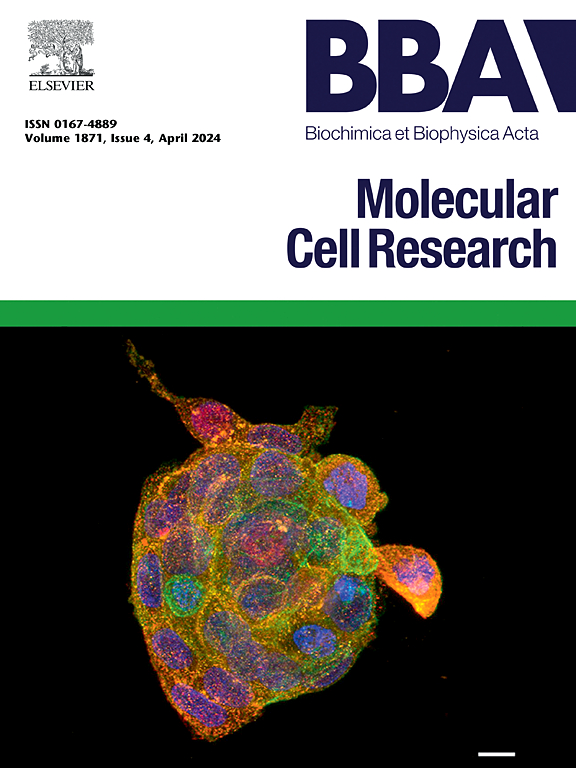HMGB1激活caspase-1,通过GABPA-ASC诱导肝星状细胞活化
IF 3.7
2区 生物学
Q1 BIOCHEMISTRY & MOLECULAR BIOLOGY
Biochimica et biophysica acta. Molecular cell research
Pub Date : 2025-07-30
DOI:10.1016/j.bbamcr.2025.120032
引用次数: 0
摘要
肝纤维化通常与炎症相关,在导致肝纤维化的复杂过程中,肝星状细胞(hsc)的激活至关重要。高迁移率组框1(HMGB1)作为细胞外环境中的内源性危险信号,调控caspase-1和肝星状细胞的激活。通过腹腔注射硫代乙酰胺(TAA)构建肝纤维化模型,揭示了TAA诱导的肝纤维化过程中HMGB1的过度表达和血清释放。腹腔注射抑制HMGB1释放的丙酮酸乙酯(EP)或AAV-shHMGB1可显著逆转TAA诱导的肝纤维化进展。采用重组HMGB1 (rHMGB1)和Z-YVAD-FMK (Caspase-1抑制剂)治疗hsc。发现HMGB1可以激活caspase-1,而Z-YVAD-FMK可以阻止HMGB1诱导的hsc活化。通过免疫荧光、免疫印迹、慢病毒转染、荧光素酶报告基因实验、染色质免疫沉淀实验发现,HMGB1通过gabpa调控ASC转录激活caspase-1,不仅参与caspase-1的激活,而且促进肝纤维化过程。综上所述,HMGB1显著驱动HSC活化。它通过GABPA促进ASC转录活性,导致caspase-1激活并促进肝纤维化的发展。本文章由计算机程序翻译,如有差异,请以英文原文为准。
HMGB1 activates caspase-1 and induces hepatic stellate cell activation via GABPA-ASC
In the intricate process leading to liver fibrosis, which frequently correlates with inflammation, the activation of hepatic stellate cells (HSCs) is critical. High mobility group box 1(HMGB1), as endogenous danger signal in the extracellular environment, governs the activation of caspase-1 and hepatic stellate cell. Constructing a liver fibrosis model via intraperitoneal thioacetamide (TAA) administration unveiled excessive HMGB1 expression and serum release during the TAA-induced fibrosis progression. Intraperitoneal injection of ethyl pyruvate (EP, which inhibits the release of HMGB1) or AAV-shHMGB1 can significantly reverse the progression of liver fibrosis induced by TAA. Recombinant HMGB1 (rHMGB1) and Z-YVAD-FMK (Caspase-1 inhibitor) were used to treat HSCs. It was found that HMGB1 could activate caspase-1, while Z-YVAD-FMK could prevent HMGB1-induced activation of HSCs. Through immunofluorescence, immunoblotting, lentiviral transfection, luciferase reporter assay and chromatin immunoprecipitation assay, it was found that HMGB1 activated caspase-1 through GABPA-regulated ASC transcription, which not only participates in the activation of caspase-1, but also promotes the process of liver fibrosis. Taken together, HMGB1 significantly drives HSC activation. It boosts ASC transcriptional activity via GABPA leading to caspase-1 activation and fostering liver fibrosis development.
求助全文
通过发布文献求助,成功后即可免费获取论文全文。
去求助
来源期刊
CiteScore
10.00
自引率
2.00%
发文量
151
审稿时长
44 days
期刊介绍:
BBA Molecular Cell Research focuses on understanding the mechanisms of cellular processes at the molecular level. These include aspects of cellular signaling, signal transduction, cell cycle, apoptosis, intracellular trafficking, secretory and endocytic pathways, biogenesis of cell organelles, cytoskeletal structures, cellular interactions, cell/tissue differentiation and cellular enzymology. Also included are studies at the interface between Cell Biology and Biophysics which apply for example novel imaging methods for characterizing cellular processes.

 求助内容:
求助内容: 应助结果提醒方式:
应助结果提醒方式:


